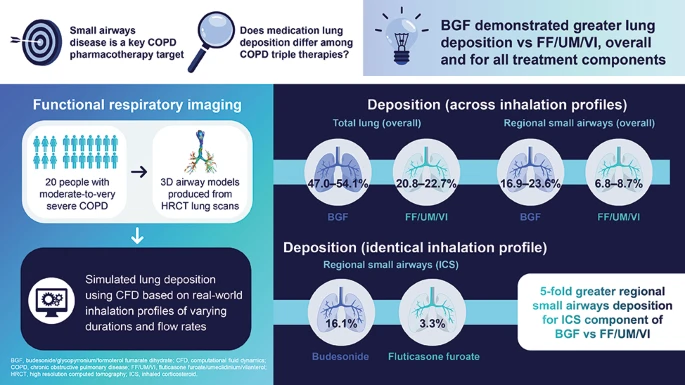Usmani, O., Li, G., De Backer, J. et al. Respir Res 24, 226 (2023). https://doi.org/10.1186/s12931-023-02534-y
Abstract
Background
Small airways disease plays a key role in the pathogenesis of chronic obstructive pulmonary disease (COPD) and is a major cause of obstruction; therefore, it is a critical pharmacotherapy target. This study evaluated lung deposition of two inhaled corticosteroid (ICS)/long-acting β2-agonist/long-acting muscarinic antagonist single-inhaler triple therapies using in silico functional respiratory imaging (FRI). Deposition was assessed using real-world inhalation profiles simulating everyday use where optimal inhalation may be compromised.
Methods
Three-dimensional airway models were produced from 20 patients with moderate-to-very severe COPD. Total, central, and regional small airways deposition as a percentage of delivered dose of budesonide/glycopyrronium/formoterol fumarate dihydrate (BGF) 160/7.2/5 µg per actuation and fluticasone furoate/umeclidinium/vilanterol (FF/UM/VI) 100/62.5/25 µg were evaluated using in silico FRI based on in vitro aerodynamic particle size distributions of each device.
Simulations were performed using multiple inhalation profiles of varying durations and flow rates representing patterns suited for a pressurized metered-dose inhaler or dry-powder inhaler (four for BGF, two for FF/UM/VI, with one common profile). For the common profile, deposition for BGF versus FF/UM/VI was compared post-hoc using paired t-tests.Results
Across inhalation profiles, mean total lung deposition was consistently higher with BGF (47.0–54.1%) versus FF/UM/VI (20.8–22.7%) and for each treatment component, with greater deposition for BGF also seen in the central large airways. Mean regional small airways deposition was also greater across inhalation profiles with BGF (16.9–23.6%) versus FF/UM/VI (6.8–8.7%) and for each treatment component. For the common profile, total, central, and regional small airways deposition were significantly greater for BGF versus FF/UM/VI (nominal p < 0.001), overall and for treatment components; notably, regional small airways deposition of the ICS components was approximately five-fold greater with budesonide versus fluticasone furoate (16.1% vs. 3.3%).
Conclusions
BGF was associated with greater total, central, and small airways deposition for all components versus FF/UM/VI. Importantly, using an identical inhalation profile, there was an approximately five-fold difference in small airways deposition for the ICS components, with only a small percentage of the ICS from FF/UM/VI reaching the small airways. Further research is needed to understand if the enhanced delivery of BGF translates to clinical benefits.
Graphical Abstract


No comments:
Post a Comment